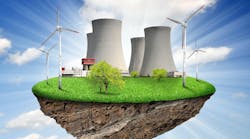HOUSTON -- Dow is setting its sights on nuclear energy as a key player in its carbon-reduction plans, with a goal to have an operational nuclear plant supplying power to its Seadrift, Texas, location by the end of the decade, says Kreshka Young, the company’s North America Business director for energy and climate.
Young discussed the company’s partnership with nuclear reactor developer X-energy during the opening keynote session at the World Chemical Forum in Houston on Sept. 12. The companies announced a partnership in March to develop the first grid-scale advanced nuclear reactor for an industrial site in North America.
Nuclear energy shows more promise than renewable energy to power chemical plants because of its ability to provide a 24/7 supply of both steam and electricity, said Young during the event hosted by Chemical Market Analytics.
“The two options that we see as being frontrunners right now are really with hydrogen combustion, linked with carbon capture, transportation and sequestration,” Young says. “But the other one really is to advance nuclear. And that's because in the chemical industry, as I'm sure you're all very well aware, we have a need not only for a lot of reliable electricity but also incredibly reliable steam.”
The project is currently in the engineering stage, with a budget of $50 million. Half of this funding is provided by Dow, while the remaining half comes from the U.S. Department of Energy's Advanced Reactor Demonstration Program. The partners expect to submit documents for the construction permit in the first quarter of 2024, Young says. That will be followed by another investment request from Dow to create a detailed facility design. Dow expects to receive the construction permit in 2026, Young says.
The planned facility will use X-energy's Gen-4, a high-temperature gas-cooled reactor. The modular configuration is smaller than traditional nuclear facilities, occupying just under 30 acres, says Marcy Sanderson, vice president, X-energy. The UCC Seadrift Operations spans 4,700 acres and produces plastics for wire and cable, glycols and oxide derivatives for health and beauty products. The plant will include “four-pack reactors” each capable of producing the equivalent of 80 MW of electricity, Young says.
A Safer Nuclear Alternative?
The technology is safer than the standard nuclear plants that most people are familiar with, says Sanderson. X-energy’s technology is called a pebble-bed reactor that the company says can’t melt down.
She likens the technology to a big gumball machine with 220,000 fuel pebbles that get loaded in the reactor. The National Energy Institute (NEI) describes the pebbles as small uranium kernels coated in concentric layers of heat-resistant materials, including graphite and wrapped together in polished spheres. The pebbles can be loaded and withdrawn while the reactor is operating, so there’s no need to shut down for refueling. Standard reactors must shut down every 18 months to two years for refueling, according to NEI.
One of the challenges Dow and X-energy must address going forward is the availability of uranium, Young says, adding that they’re working with the DOE to secure domestic fuel. Most uranium has traditionally been sourced from Russia, but a U.S. House committee passed a bill in May to ban uranium imports from Russia.
Nuclear will play a role along with renewables, including blue hydrogen, in Dow’s efforts to reach its net zero goals by 2050, says Young.
“I'll say that it's not our goal to be sort of one and done with nuclear,” she says.

